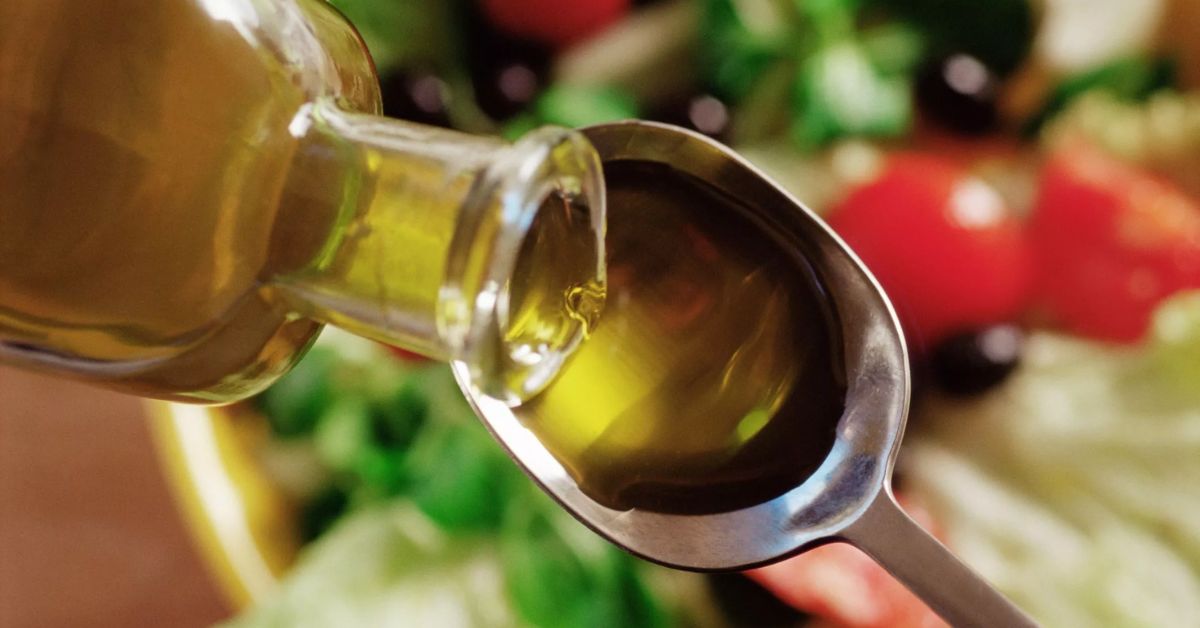Olive oil is a kitchen staple prized for its health benefits and culinary versatility. However, when it accidentally lands on your favorite shirt or pants, it can quickly become a source of frustration.
Olive oil stains can be stubborn and, if not treated properly, may become permanent. But don’t worry – with the right techniques and a bit of patience, you can successfully remove olive oil stains from most fabrics.
Removing olive oil stains from clothing can be tricky, but with the right approach, you can salvage your favorite garments.
Begin by acting quickly the fresher the stain, the easier it is to remove. Start by gently blotting the stain with a clean cloth or paper towel to absorb excess oil, being careful not to rub and spread the stain further.
Next, apply a small amount of dish soap directly to the stain. Dish soap is particularly effective because it’s designed to break down oils. Work the soap into the fabric using your fingers or a soft-bristled brush, then let it sit for about 15 minutes to penetrate the stain.
After the waiting period, rinse the garment thoroughly with cold water to remove the soap and loosened oil. For stubborn stains, create a paste using equal parts baking soda and water, apply it to the stain, and let it sit for an additional 15 minutes before rinsing.
Understanding Olive Oil Stains on Fabric

Before diving into removal methods, it’s important to understand why olive oil stains can be so challenging to remove.
Characteristics of Olive Oil Stains
Olive oil stains have several properties that make them tricky to deal with:
- Oily nature: As a lipid, olive oil doesn’t mix with water, making it resistant to simple washing.
- Absorption: Fabric fibers can quickly absorb olive oil, allowing it to penetrate deeply.
- Color: While initially clear, olive oil can darken over time, leaving a yellowish stain.
- Heat sensitivity: Heat can set the stain, making it more difficult to remove.
- Fabric interaction: Different fabrics react differently to olive oil, affecting the ease of removal.
Understanding these characteristics helps in choosing the most effective removal methods and avoiding actions that might set the stain permanently.
Quick Actions to Take When Olive Oil Spills on Clothes

When olive oil first spills on your clothes, taking immediate action can significantly increase your chances of complete stain removal.
Immediate Steps:
Blot, don’t rub: Use a clean cloth or paper towel to blot excess oil. Avoid rubbing, as this can spread the stain and push it deeper into the fabric.
Apply an absorbent powder: Sprinkle cornstarch, baby powder, or baking soda on the stain. These powders can help absorb excess oil before it sets.
Let it sit: Allow the powder to sit on the stain for at least 15-30 minutes. You may see it clump as it absorbs the oil.
Brush off the powder: Gently brush off the powder with a soft brush or shake the garment outside.
Check the care label: Before proceeding with any treatment, always check the garment’s care label for specific instructions or warnings.
Remember, the fresher the stain, the easier it is to remove. Don’t let olive oil stains sit for long periods if you can help it.
READ THIS BLOG: How To Get Musty Smells Out Of Clothes?
Pre-Treating Olive Oil Stains for Effective Removal

Proper pre-treatment can make a significant difference in the success of your stain removal efforts.
Pre-Treatment Steps:
- Test in an inconspicuous area: Before applying any cleaning solution, test it on a hidden part of the garment to ensure it doesn’t cause discoloration.
- Apply dish soap: Liquid dish soap is designed to cut through grease and can be effective on olive oil stains. Gently work a small amount into the stain with your fingers.
- Let it sit: Allow the dish soap to sit on the stain for about 5 minutes to start breaking down the oil.
- Rinse with warm water: Rinse the treated area with warm water to remove the soap and loosened oil.
- Repeat if necessary: For stubborn stains, you may need to repeat this process several times.
These pre-treatment steps help to break down the oil and prepare the stain for more thorough cleaning methods.
Using Dish Soap to Break Down Olive Oil Stains

Dish soap is one of the most effective household items for tackling olive oil stains due to its grease-cutting properties.
Dish Soap Method:
- the right soap: Opt for a grease-fighting dish soap without added moisturizers or bleach.
- Apply directly: Squeeze a small amount of dish soap directly onto the stain.
- Work it in: Use your fingers to gently work the soap into the fabric, creating a lather.
- Let it sit: Allow thChoose a soap to sit on the stain for at least 15 minutes.
- Rinse and check: Rinse the area with warm water and check if the stain has improved. Repeat if necessary.
For best results, use lukewarm water when rinsing, as hot water can set the stain.
READ THIS BLOG: How To Get Dry Erase Marker Out Of Clothes
How to Apply Baking Soda for Absorbing Olive Oil?
Baking soda is an excellent absorbent that can help draw out olive oil from fabric fibers.
Baking Soda Technique:
- Sprinkle generously: Cover the entire stained area with a thick layer of baking soda.
- Press it in: Gently press the baking soda into the stain to ensure good contact with the oil.
- Wait patiently: Let the baking soda sit for at least 30 minutes, or even overnight for stubborn stains.
- Brush off: Use a soft brush to remove the baking soda. You may notice it has clumped together as it absorbed the oil.
- Repeat if needed: For large or set-in stains, you may need to repeat this process several times.
After using baking soda, proceed with washing the garment as usual or apply additional treatments if the stain persists.
Best Laundry Detergents for Removing Olive Oil Stains

Choosing the right laundry detergent can make a significant difference in removing olive oil stains.
Effective Detergent Options:
- Heavy-duty liquid detergents: These are generally more effective on oily stains than powder detergents.
- Enzyme-based detergents: Enzymes can break down oils and fats, making them ideal for olive oil stains.
- Detergents with built-in stain removers: Some detergents come with added stain-fighting ingredients that can boost their effectiveness.
- Eco-friendly options: Many plant-based detergents are surprisingly effective at tackling oil stains.
- Pre-treat products: Stain-removing sprays or sticks can be used in conjunction with your regular detergent for extra stain-fighting power.
When using any detergent, always follow the instructions on the product label and the garment’s care tag.
Special Tips for Treating Delicate Fabrics
Delicate fabrics like silk, wool, or certain synthetics require extra care when removing olive oil stains.
Gentle Removal Techniques:
- Use a mild, pH-neutral detergent specifically designed for delicate fabrics.
- Avoid harsh chemicals or excessive rubbing that could damage the fabric.
- Consider using a fabric-safe stain remover designed for use on delicate materials.
- Dab the stain gently with a clean, white cloth instead of scrubbing.
- For valuable or particularly delicate items, consider professional cleaning services.
When in doubt, it’s always better to err on the side of caution with delicate fabrics. A professional cleaner may have specialized techniques for safely removing olive oil stains without damaging the garment.
Final Steps: Washing and Drying Clothes After Stain Removal

After treating the olive oil stain, proper washing and drying are crucial to ensure complete removal and prevent any residual oil from setting into the fabric.
Washing Guidelines:
- Use the hottest water temperature safe for the fabric, as indicated on the care label.
- Add the appropriate amount of detergent, considering using slightly more for heavily stained items.
- Avoid overloading the washing machine to ensure thorough cleaning.
- Consider adding a laundry booster or stain remover to the wash for extra cleaning power.
Drying Best Practices:
- Check the garment thoroughly before drying to ensure the stain is completely gone.
- If any trace of the stain remains, repeat the treatment process before drying.
- Air dry the garment if possible, as this allows you to check for any remaining stain before heat-setting it.
- If using a dryer, use the lowest heat setting appropriate for the fabric to avoid setting any residual stain.
By following these final steps, you give your garment the best chance of emerging stain-free and undamaged.
FAQ’s
Can vinegar remove olive oil stains from clothes?
While vinegar is great for many stains, it’s not typically effective on oil stains. Dish soap or specialized degreasers work better.
Is it possible to remove old, set-in olive oil stains?
Yes, but it’s more challenging. Try soaking in warm water with dish soap before treating with baking soda and laundering.
Can I use hairspray to remove olive oil stains?
Hairspray isn’t recommended for olive oil stains. It’s more effective on ink stains.
Will dry cleaning remove olive oil stains?
Yes, professional dry cleaning can be very effective at removing olive oil stains, especially from delicate fabrics.
Can I use bleach to remove olive oil stains from white clothes?
While bleach can help, it’s better to try oil-specific removal methods first, as bleach can damage fabric and may not effectively remove the oil.
Conclusion
Removing olive oil stains from clothes can be challenging, but with the right techniques and a bit of persistence, it’s often possible to completely eliminate these stubborn marks. By acting quickly, using effective pre-treatment methods, and choosing the right cleaning agents, you can tackle olive oil stains on various fabrics.
Remember to always check garment care labels, test cleaning solutions in inconspicuous areas, and be patient – sometimes multiple treatments may be necessary for complete stain removal.
With these tips and techniques in your arsenal, you can face olive oil spills with confidence, knowing that your favorite clothes have a good chance of coming out clean and fresh.

Hayyat is an experienced content writer and digital marketer, skilled in creating SEO-friendly content that resonates with audiences. She helps brands enhance their online presence through targeted campaigns, with expertise in blog writing, social media management, email marketing, and SEO optimization.





